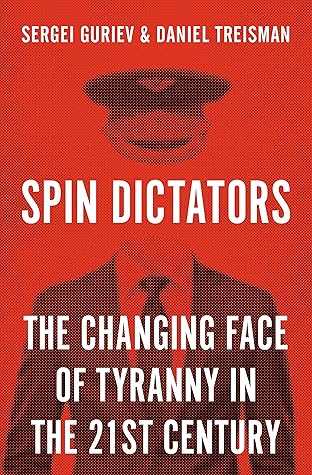More on this book
Kindle Notes & Highlights
Read between
September 23, 2022 - May 21, 2023
Instead of terrorizing citizens, a skillful ruler can control them by reshaping their beliefs about the world.
Sergei headed a Moscow university specializing in economics and advised the Russian government. Daniel was a professor in the West studying Russia’s postcommunist politics. In the spring of 2013, Sergei received a visit from some of Putin’s security agents, who confiscated his emails and copied his computer hard drive. He had helped write a critical analysis of the latest court verdict against Mikhail Khodorkovsky, a billionaire who had been jailed on a dubious charge. Apparently, the Kremlin did not like this analysis. Soon after, Sergei moved to France.3
Two new types of regime—communist and fascist—set out to mobilize the lower classes. Each promised a complete transformation of society. Vladimir Lenin’s Bolsheviks aimed to build communism in the remnants of the Russian Empire. The Nazis, under Adolf Hitler, planned an Aryan empire. On taking power, both forced the public to adopt an ideology distilled from the leader’s scribblings. Raymond Aron called these “secular religions.” Like traditional faiths, they stated truths not to be questioned, redirected attention from current hardship to a utopian future, and defined rituals that could sort
...more
A third new model—corporatism—aimed not to mobilize the masses into politics but to demobilize them into private life. Conservatives such as Portugal’s António Salazar and Spain’s Francisco Franco wanted to restore social deference and Catholic hierarchy.15 In place of noisy parliaments, they created consultative chambers where selected spokesmen of social groups could advise the leader. Like the other two forms, corporatism was born out of disgust with the present. But while fascists and communists sought to escape into an imagined future, corporatists hoped to return to an imagined past.
The Haitian strongman François “Papa Doc” Duvalier propped a headless corpse at a street corner in Port-au-Prince for three days with a sign reading “renegade.”20 Almost all adopted a menacing rhetoric to spread anxiety and discourage challenges. Iraq’s Saddam Hussein spoke of “cutting off necks” and “evildoers … who have thrust their poisoned dagger into our back.”21 Spain’s Franco warned of “internal subversion” by an enemy who “lies in wait for opportunities to penetrate.”
In short, most dictators maintained power by repressing any opposition, controlling all communications, punishing critics, (often) imposing an ideology, attacking the ideal of pluralist democracy, and blocking most cross-border flows of people and information. The key principle behind all these practices was simple: intimidation. The typical twentieth-century autocrat was a dictator of fear.
Spin dictators survive not by disrupting rebellion but by removing the desire to rebel.
In an influential book, Steven Levitsky and Lucan Way pointed out that many elections held by dictators are—although unfair—not completely unfree. Opposition parties run and even have some chance of winning.
The key elements—manipulating the media, engineering popularity, faking democracy, limiting public violence, and opening up to the world—complement each other to produce a model of unfree governance that is spreading.
Later, in a similar vein, Machiavelli advised princes to use “simulation and dissimulation.”44 Since most people are influenced by appearances rather than reality, an ambitious ruler should create illusions. He “need not have all the good qualities … but he must seem to have them.”45 How to fool the public depends on context: “The prince can gain popular favor in many ways.” But obtaining public support is crucial. “I will only say in conclusion that a prince must have the people on his side.”
Instead, their first line of defense, when the truth is against them, is to distort it. They manipulate information.
To do this effectively requires foresight. In good times, they prepare for bad. Claiming responsibility for successes—even those caused by luck—they build a reputation for professionalism. And, like Aristotle’s second tyrant, they pretend to govern for the benefit of all. At the same time, they consolidate control over the media, often discreetly in order to preserve its credibility, quietly buying off owners and encouraging self-censorship. This enables them, at tougher moments, to divert attention from disappointing outcomes and retarget blame to others. Despite failures, spin dictators can
...more
The spin dictator’s key challenge is to prevent the informed from puncturing his popularity and mobilizing the public against him. But how? When state coffers are full, he can co-opt his critics. He can buy their silence or even hire them to produce his propaganda. In Putin’s Russia and Nazarbayev’s Kazakhstan, pro-regime TV networks recruited the country’s talented college graduates. Other leaders—from Peru’s Alberto Fujimori to Hungary’s Viktor Orbán—have bribed private media barons with payoffs, scoops, and government advertising. When short of money, dictators censor the informed and their
...more
Dissident intellectuals are allowed their edgy journals, cable shows, and foreign newspapers, so long as demand is low. What matters is mass support. To divide the public from the informed, rulers insult the latter, question their motives, label them unpatriotic or elitist, and inflame cultural resentments.
Having won mass appeal, the leader uses his popularity to consolidate power. This is the second rule of spin dictatorship. Popularity is a fluid asset that can fall as well as rise. So it makes sense to invest some of it into other levers of control. To cash in his high ratings, a spin dictator calls elections and referenda and, winning huge victories, claims a mandate to adjust political and legal institutions. He enacts constitutional changes, packs courts and regulatory bodies with loyalists, and gerrymanders voting districts to build a cushion of institutional support. The third rule is to
...more
Other skeptics suggest it is not dictators that are growing less violent but societies that are becoming less rebellious. As people get richer, they become more risk averse. With more to lose, citizens lose their taste for revolution. A dictator may need less graphic brutality and fewer explicit threats to keep such a population in line.


